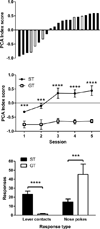Sign-tracking predicts increased choice of cocaine over food in rats
- PMID: 25541036
- PMCID: PMC4305489
- DOI: 10.1016/j.bbr.2014.12.034
Sign-tracking predicts increased choice of cocaine over food in rats
Abstract
The purpose of this study was to determine whether the tendency to sign-track to a food cue was predictive of rats' choice of cocaine over food. First, rats were trained on a procedure where insertion of a retractable lever was paired with food. A sub-group of rats - sign-trackers - primarily approached and contacted the lever, while another sub-group - goal-trackers - approached the site of food delivery. Rats were then trained on a choice task where they could choose between an infusion of cocaine (1.0 mg/kg) and a food pellet (45 mg). Sign-trackers chose cocaine over food significantly more often than did goal-trackers. These results support the incentive-salience theory of addiction and add to a growing number of studies which suggest that sign-trackers may model an addiction-prone phenotype.
Keywords: Addiction; Choice; Cocaine self-administration; Goal-tracking; Sign-tracking.
Copyright © 2014 Elsevier B.V. All rights reserved.
Figures



Similar articles
-
Sign- and goal-tracking score does not correlate with addiction-like behavior following prolonged cocaine self-administration.Psychopharmacology (Berl). 2021 Aug;238(8):2335-2346. doi: 10.1007/s00213-021-05858-z. Epub 2021 May 5. Psychopharmacology (Berl). 2021. PMID: 33950271 Free PMC article.
-
Individual differences in food cue responsivity are associated with acute and repeated cocaine-induced vocalizations, but not cue-induced vocalizations.Psychopharmacology (Berl). 2017 Feb;234(3):437-446. doi: 10.1007/s00213-016-4476-6. Epub 2016 Nov 11. Psychopharmacology (Berl). 2017. PMID: 27837333 Free PMC article.
-
Individual differences in the attribution of incentive salience to a reward-related cue: influence on cocaine sensitization.Behav Brain Res. 2008 Jan 10;186(1):48-56. doi: 10.1016/j.bbr.2007.07.022. Epub 2007 Jul 21. Behav Brain Res. 2008. PMID: 17719099 Free PMC article.
-
Individual differences in the attribution of incentive salience to reward-related cues: Implications for addiction.Neuropharmacology. 2009;56 Suppl 1(Suppl 1):139-48. doi: 10.1016/j.neuropharm.2008.06.027. Epub 2008 Jun 21. Neuropharmacology. 2009. PMID: 18619474 Free PMC article. Review.
-
On the motivational properties of reward cues: Individual differences.Neuropharmacology. 2014 Jan;76 Pt B(0 0):450-9. doi: 10.1016/j.neuropharm.2013.05.040. Epub 2013 Jun 7. Neuropharmacology. 2014. PMID: 23748094 Free PMC article. Review.
Cited by
-
Comment on Pohorala et al.: Sign-tracking as a predictor of addiction vulnerability.Psychopharmacology (Berl). 2021 Sep;238(9):2661-2664. doi: 10.1007/s00213-021-05927-3. Epub 2021 Jul 26. Psychopharmacology (Berl). 2021. PMID: 34308488 Free PMC article. No abstract available.
-
Choose your path: Divergent basolateral amygdala efferents differentially mediate incentive motivation, flexibility and decision-making.Behav Brain Res. 2021 Jul 9;409:113306. doi: 10.1016/j.bbr.2021.113306. Epub 2021 Apr 19. Behav Brain Res. 2021. PMID: 33887310 Free PMC article. Review.
-
Insula lesions reduce stimulus-driven control of behavior during odor-guided decision-making and autoshaping.Brain Res. 2022 Jun 15;1785:147885. doi: 10.1016/j.brainres.2022.147885. Epub 2022 Mar 17. Brain Res. 2022. PMID: 35307330 Free PMC article.
-
Modeling neuroaffective biomarkers of drug addiction: A Bayesian nonparametric approach using dirichlet process mixtures.J Neurosci Methods. 2020 Jul 15;341:108753. doi: 10.1016/j.jneumeth.2020.108753. Epub 2020 May 16. J Neurosci Methods. 2020. PMID: 32428623 Free PMC article.
-
Animal Models of the Behavioral Symptoms of Substance Use Disorders.Cold Spring Harb Perspect Med. 2021 Aug 2;11(8):a040287. doi: 10.1101/cshperspect.a040287. Cold Spring Harb Perspect Med. 2021. PMID: 32513674 Free PMC article. Review.
References
-
- Ahmed SH. Validation crisis in animal models of drug addiction: beyond non-disordered drug use toward drug addiction. Neurosci Biobehav Rev. 2010;35:172–184. - PubMed
-
- Anderson SM, Schmidt HD, Pierce RC. Administration of the D2 dopamine receptor antagonist sulpiride into the shell, but not the core, of the nucleus accumbens attenuates cocaine priming-induced reinstatement of drug seeking. Neuropsychopharmacology. 2006;31:1452–1461. - PubMed
-
- Augier E, Vouillac C, Ahmed SH. Diazepam promotes choice of abstinence in cocaine self-administering rats. Addict Biol. 2012;17:378–391. - PubMed
-
- Bari AA, Pierce RC. D1-like and D2 dopamine receptor antagonists administered into the shell subregion of the rat nucleus accumbens decrease cocaine, but not food, reinforcement. Neuroscience. 2005;135:959–968. - PubMed
Publication types
MeSH terms
Substances
Grants and funding
LinkOut - more resources
Full Text Sources
Other Literature Sources

